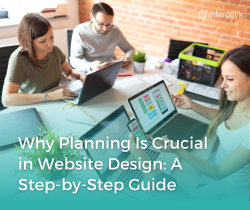Planning is a fundamental part of the website design process that sets the stage for a successful, efficient project. Without careful planning, even the most visually stunning website can fall short in functionality, user experience, and overall effectiveness. A well-organized approach ensures that the site meets business goals, serves its audience, and stays on budget and timeline. Here’s a step-by-step guide on why planning is so essential and how to approach it effectively.
Step 1: Define Your Goals and Purpose
Every website needs a clear purpose, whether it’s to showcase a portfolio, sell products, provide information, or generate leads. Identifying your primary goals at the outset helps direct every decision in the design process. For example, an e-commerce website needs features like product pages, shopping carts, and secure checkout options, while a blog or news site will focus on content organization and readability. Defining these objectives prevents costly redesigns and ensures the final product supports your goals.
Step 2: Identify Your Target Audience
Understanding who your target audience is and what they need from your website is crucial for creating a user-centered design. A website designed with its users in mind will encourage engagement and conversions. During the planning phase, consider factors like your audience’s age, interests, browsing habits, and the devices they’re likely to use. Tailoring the site’s layout, features, and language to fit your audience’s preferences can make the difference between a site that engages users and one that they leave within seconds.
Step 3: Conduct a Competitor Analysis
Looking at competitors’ websites can provide valuable insights into industry standards and user expectations. Analyze the features, layouts, and functionality that similar businesses use on their websites. Take note of what works well and where there’s room for improvement. Competitor analysis can help you identify opportunities to differentiate your website, whether through a unique design style, added functionality, or enhanced user experience.
Step 4: Create a Site Map
A site map is a visual or written structure of all the pages on a website and how they connect to one another. It serves as the blueprint for your site’s architecture, helping ensure that users can navigate intuitively and find what they need. The site map includes key pages, subpages, and their relationships, as well as main navigation paths. This step prevents future navigation issues and helps designers and developers understand the project scope, minimizing confusion and revisions later.
Step 5: Develop Wireframes
Wireframes are simplified layouts that outline the placement of elements like headers, images, buttons, and text areas on each page. While wireframes don’t include final colors or designs, they provide a structural framework that guides the design process. Creating wireframes allows you to experiment with different layouts, test functionality, and ensure that essential elements are positioned in a way that enhances the user experience. Wireframes are an important planning tool, as they allow for feedback and adjustments before investing in detailed design and development.
Step 6: Plan Content Strategy and SEO
Content is the backbone of any website. Planning a content strategy ensures that your message is clear, consistent, and aligned with your brand voice. It’s also essential to consider SEO (search engine optimization) at this stage, as proper keyword integration, metadata, and URL structure can significantly impact the site’s visibility on search engines. Content planning helps streamline the design and development phases, making sure that space is allocated for all necessary text, images, videos, and calls to action.
Conclusion
Planning in website design is the foundation for creating a site that is visually appealing, user-friendly, and effective at meeting business goals. Each step—goal-setting, audience identification, competitor analysis, site mapping, wireframing, and content planning—ensures that the project stays focused, reduces costly revisions, and leads to a well-structured, user-centered site. By investing time in careful planning, you’ll create a website that not only looks great but also functions seamlessly, delivering a valuable experience to users and a successful outcome for your business.

